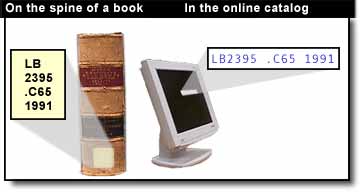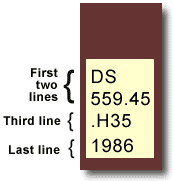The ECAE Library uses the Library of Congress (LC) classification system. This system organizes books and other library materials by subject, to make it easier for you to browse the shelves for materials on a specific topic. Library of Congress call numbers always begin with letters of the alphabet. This system is organized into 21 main classes which are designated by letters of the alphabet.
It is possible to search by call number in the library catalog. The partial outline below may also be useful for browsing the shelves:
- A -- General Works
- B -- Philosophy, Psychology, Religion
- C -- Auxiliary Sciences of History (Genealogy, Archaeology, Biography, etc.)
- D -- History (General) and History of Europe
- E -- History: America
- F -- History: America
- G -- Geography, Anthropology, Recreation
- H -- Social Sciences
- J -- Political Science
- K -- Law
- L -- Education
- M -- Music and Books on Music
- N -- Fine Arts
- P -- Language and Literature
- Q -- Science
- R -- Medicine
- S -- Agriculture
- T -- Technology
- U -- Military Science
- V -- Naval Science
- Z -- Bibliography, Library Science
Each book is given a unique call number according to the LC system, and the books are arranged on the shelves in order by that call number which is alphanumeric.
The following call numbers are in order as you would find them on the shelf. Note that the first number in the call number is treated as a whole number (PS25 comes before PS132) and that the second number is treated as a decimal (G294 comes before G38).
| Call Number Examples in Order | ||||
|---|---|---|---|---|
|
PA 2143 .R24 |
PS 25 .F12 |
PS 132 .G294 |
PS 132 .G38 |
PS 1163 .B26 |
See the Library of Congress Classification Outline for the complete classification system.
Reading a Call Number
- LC call numbers are first arranged alphabetically, according to the letter or letters at the beginning of the call number, which correspond to the subject matter of the item.
Example: Call numbers beginning with P are followed by PA, PB, PC, etc. - Within the alphabetical section, books are arranged by the number(s) that follow. Notice that these numbers are regarded as whole numbers. For instance, PS 1200 comes after PS 345.
Example: QA 56 before QA 234 before QA 234.57 before QA 234.8 - The next lines are alphabetic, then numeric as a decimal. The numerical part of this section is a decimal number, not a whole number. Use alphabetical order first, then the decimal extension to put the call numbers in correct sequence. (A3113 would come before A4, because 0.3113 is smaller than 0.4.)
Example: HV 1431 .B7 before HV 1431 .B83 before HV 1431 .F25 before HV 1431 .F7 - Editions are often arranged by date or by the date and letters.
Example: PS 3525 .I52 1971 before PS 3525 .I52 1973 before PS 3525 .I52 1973a







